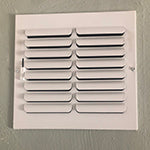On All Orders Within The Contiguous U.S.
On All Orders Within The Contiguous U.S.
 You are probably aware that your home was built with a network of ducts hidden behind the walls, but do you know their purpose? The ducts provide a pathway for air to cycle through every room in your home, to and from your HVAC system. This circulation process; however, would not be possible without the supply and return air vents you see throughout your house. But what is the difference between supply and return vents?
You are probably aware that your home was built with a network of ducts hidden behind the walls, but do you know their purpose? The ducts provide a pathway for air to cycle through every room in your home, to and from your HVAC system. This circulation process; however, would not be possible without the supply and return air vents you see throughout your house. But what is the difference between supply and return vents?
It’s easy to think that your AC and furnace simply blow heated or cooled air to the rooms in your house. But another very important part of the cycle of air is happening as well - sucking air out of the rooms. This is where the difference between supply vs return vents comes into play.
Supply Vents: These air vents blow conditioned air out. They are easy to identify as they are the ones you feel the cool air coming from. The air coming from these vents has traveled through your HVAC system, through the ducts and out of the supply vents. Supply vents are usually found high up on the walls in your home, or on the ceiling.
Return Vents: These air vents suck air from the rooms in your home back into your HVAC system. They are typically larger in size than supply vents and you will not feel air blowing out of them. Return vents are usually found closer to the bottom of the walls in your home, near the floorboard, but depends upon the location of your ductwork.
The HVAC system in your house is meant to maintain a balance environment inside the ductwork. In order to do this, the amount of air the ducts blow out should be nearly equal to the amount of air that's being sucked back into the ductwork. If there is an inadequate amount of supply and return vents, the pressure inside the ducts becomes unbalanced, causing your home to feel less comfortable. If you're building a home or installing a new system, make sure precise measurements are taken of your home's air flow needs before the HVAC system is installed.
There are a few things you can do to make sure your supply and return vents are performing at their best, even if you have the correct amount in your home.
No matter which HVAC system you have, every unit needs a quality filter that fits properly in order to keep your indoor air quality clean and your unit running at its maximum efficiency. US Home Filter can supply you with the best and most efficient HVAC filter available! Changing the filter is as important as changing the oil in your car and US Home Filter makes filters that fit all AC/HVAC units. From standard to custom air filters, to whole-house filters, grille filters and humidifier filters, we have all of your filter needs covered!
Selecting the filters that are just right for your home can be difficult and confusing at times. At US Home Filter we understand this, which is why we offer an experienced staff to help answer any questions you may have. For personal assistance with your air filter needs, please contact us now online or call us at (855) 237-1673 and we will do our very best to assist you in selecting the right filter for your individual needs. We want to earn your business and we guarantee your satisfaction! Take advantage of our quality products, vast selection, low prices, and enjoy FREE SHIPPING on every air filter order within the Contiguous USA.